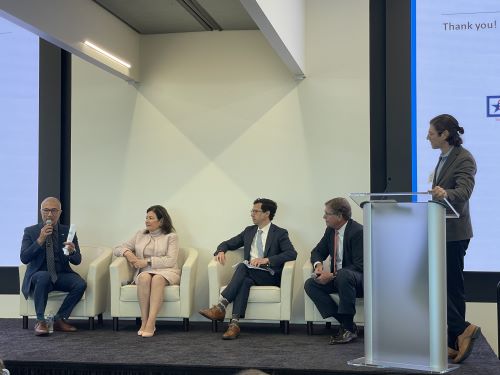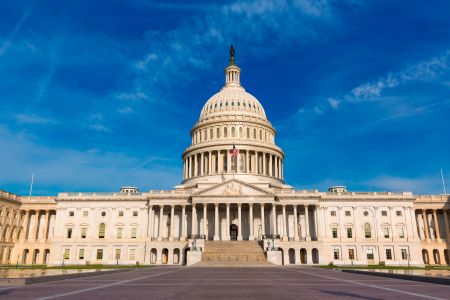DACA: What Next?
 Authored by Chelsie Kramer, State Organizer for the American Immigration Council, and originally published by the Texas Association of Business
Authored by Chelsie Kramer, State Organizer for the American Immigration Council, and originally published by the Texas Association of Business
Texas Association of Business (TAB) hosted the last installment of their webinar series on immigration: DACA: What Next?
Over the last several weeks, business leaders from TAB have discussed the vital economic impact immigrants have on the economy and the need for visa reforms to meet the needs of the Texas workforce. This week, experts from the American Immigration Council (the Council), the Cato Institute, and FWD.us joined TAB to discuss the very timely topic of the Deferred Action for Childhood Arrivals program, better known as DACA.
What is DACA?
The discussion started with Maria Praeli, who serves as the government relations manager for FWD.us and is a DACA recipient, explaining the DACA policy. Maria said that DACA is a policy launched in 2012 by the Obama Administration that allows qualifying individuals brought to the United States as undocumented children to have work authorization and protection from deportation. Among other criteria that applicants must prove to the government, DACA applicants must have entered before 2007, be under the age of 16, achieved a certain level of education, and pass a security background check. “It’s a two-year renewable protection, so every two years, folks like myself have to renew their application; they also have to pay a fee of about $495 to have their application reviewed, processed, and adjudicated.” Maria expanded by noting that the process is not easy, and there is no guarantee a DACA recipient will receive a renewal once their two-year permit expires, especially as the policy works its way through the court system.
To dispel a common misconception about why DACA recipients don’t just apply for citizenship, Maria clarified that DACA does not create pathways for DACA recipients to achieve citizenship. “Unfortunately, there are not enough legal avenues that exist for folks like myself and many others to be able to adjust their status.”
As moderator, I shared research by the American Immigration Council, which shows there are more than 200,000 DACA-eligible residents in Texas, 95.2% of whom are employed. Jorge Loweree from the Council reiterated that while DACA is helpful to the recipients, protections are only available in two-year increments, which means they endure a level of uncertainty that no one else experiences. “The prospect that you may lose your ability to work in the U.S. lawfully and possibly even remain here at any point makes trying to build your life in the U.S., to make big decisions, like whether or not to pursue higher education, whether or not to get married, to buy a house, etc., makes those all fundamentally more difficult…given all of that the dedication of DACA recipients and their contributions to our communities…it’s long past time for Congress to do the right thing.”
The Biden Administration Final Rule
David Bier, the associate director of immigration studies at the Cato Institute, discussed the recent development of the Biden Administration publishing the final rule for DACA. David explained the final rule that will go into effect on October 31st codifies DACA into federal regulation and is meant to replace the 2012 Department of Homeland Security (DHS) memorandum that has governed the program for the past decade, which is currently being argued in the courts.
“[This final rule] will remove one of the legal objections to that program, that it didn’t go through the notice and public comment procedures of the Administrative Procedure Act. [The final rule] is a way of trying to, in the administration’s terms, fortify and protect the DACA program. And if it is successful, it would reopen DACA applications to first-time applicants,” said David.
Still, the final DACA rule is disappointing to many because it does not expand and update DACA to allow more undocumented children to benefit from the program. Instead, the Biden administration’s goal with the final rule was a legal grounding that could be argued in court that DACA is a legal process and should be allowed to go forward. If successful in the courts, the potential gain is that it would open the application processes to over 100,000 DACA-eligible residents who could not apply previously.
Even with the new rule going into effect later this fall, DHS cannot process new DACA applications while Judge Hanen’s 2021 ruling that DACA is illegal is in effect.
Texas V. United States (DACA) - The Impending Fifth Circuit Court of Appeals Decision
Despite the Biden Administration's efforts to protect DACA with the final rule, the program’s recipients are still under a dark cloud of uncertainty concerning the impending decision from the Fifth Circuit Court of Appeals on the 2021 ruling mentioned above by Texas federal Judge Hanen.
Jorge Loweree, managing director of programs and strategy for the American Immigration Council, explained there have been various legal challenges to DACA on how the program is structured. The current challenge began in 2018 when Texas, again, along with several other states, sued to overturn the program.
The case was assigned to Judge Hanen, who struck down DACA on July 16, 2021, and ordered U.S. Citizenship and Immigration Services (USCIS) to stop issuing new DACA benefits. Judge Hanen found that the program was illegal both in substance and in its implementation, ruling that the Obama Administration had gone through the wrong process in creating DACA and that the program itself violated the law. However, in recognition of the impact of terminating DACA and immediately affecting the 600,000 people who were part of the program at the time, Judge Hanen paused the portion of his decision that would have required the agency to terminate any DACA protections or renewals for people already part of the program while his decision goes through the appeals process. Since Judge Hanen’s ruling, the program has been limited to people who previously benefited from it.
The Judge Hanen decision was appealed to the Fifth Circuit Court of Appeals, and oral arguments were held early July this year. During the intervening period, the Biden administration published the new final rule, intended to shield DACA from litigation challenges. After the rule was finalized, the Fifth Circuit Court ordered the parties to submit an additional briefing on how the new regulation affects the legal issues; that briefing concluded two weeks ago on September 1st. The decision could come at any moment.
There are several possible scenarios at this point. Some would allow current DACA recipients to maintain and renew their protections. “But there is also the very real possibility the Fifth Circuit could render a decision on the merits… effectively ending the program for anyone who is part of it at the moment of the decision. It goes without saying that it is a potentially devastating outcome that would create a crisis in the lives of 600,000 or so people across this country…and quite frankly, why we believe now is the time to discuss and negotiate a long-term solution for DACA recipients in Congress. Congress can’t seem to get much of anything done unless there is an emergency, and there is certainly one brewing behind the scenes right now,” Jorge said.
DACA’s Impact
“If DACA were to end, as Jorge alluded to as one of the possible scenarios…we estimate that about 1,000 DACA recipients a day would be following out of status because their application would not be adjudicated,” Maria explained. An unfavorable court decision would negatively affect every sector and every community. In Texas, that would mean 400 healthcare workers and 300 teachers would lose their jobs each month.
David then explained if DACA recipients lose work authorization, employers will scramble to recruit and train replacements. Undoubtedly, those costs would be passed down to consumers, add to inflation, lower profitability, and have broader economic implications. “Ending DACA will be a self-inflicted blow to the economy.” The Cato Institute found that “completely reversing DACA would cost the economy $350 billion over a ten-year period, and the treasury would lose about $100 billion over ten years. “The big picture here,” said David, “is that DACA is fuel for growth because you incentivize people to get educated, graduate from high school, and invest in their own skills.” He explained that if DACA recipients lose authorization, it will have horrible personal effects and a tremendous negative economic effect.
According to Jorge and research by the Council, at least 250,000 American children have at least one parent who is a DACA recipient. The negative impact on families cannot be understated, “we are not just talking about the individual with the protections for a two-year period in isolation. The ties people have developed over the last ten years while participating in the initiative are significant, and it makes no sense for us to backtrack from where we are. We must find a path forward to create a permanent solution for them.”
Why Hasn’t Congress Done Anything and What Next?
“It’s a combination of factors,” said Jorge, “one is the dysfunctional place that our politics is now in and that DACA has been weaponized in a way that has prevented progress from happening. There is also the idea that DACA recipients are “okay” under the program.” This, of course, is not taking into account the significant stress associated with 2-year protections and constant litigation that could end those protections at any moment.
Immigration is a highly complicated issue, and for complex problems, Congress has traditionally needed an emergency to act. There hasn’t been one to force Congress's hand up to this point.
David added, “the House of Representatives has acted; they passed legislation, the Dream and Promise Act, that would create a path to citizenship for not just the DACA participants, but a much broader group of Dreamers, and the Senate hasn’t taken it up. So, when we are talking about Congress, we are really talking about the Senate's inability to agree on some kind of way forward on the DACA program.” David agreed with Jorge that an emergency is needed to force the Senate to agree on DACA.
Using the Fifth Circuit decision as a moment to fight advocacy fatigue and continue to elevate the vital contribution of the DACA-eligible population is the key to encouraging Congress to take action.
“At the end of the day, people like myself are just asking to be recognized as full members of society in the country we know and call home. The average DACA recipient has lived in the United States for twenty-four years,” said Maria, “we are so ingrained in the fabric of this country and just want the opportunity to live with the security and safety of knowing that when our work permit expires, we will still be able to live and contribute fully in the country that we call home.”
Resources:
· The American Immigration Council: Deferred Action for Childhood Arrivals (DACA): An Overview
· FWD.us: What happens if DACA ends?
· The Cato Institute: A New Estimate of the Cost of Reversing DACA
· Texas Association of Business: Clear a path to citizenship for immigrants
Texas business coalition: Texans for Economic Growth







